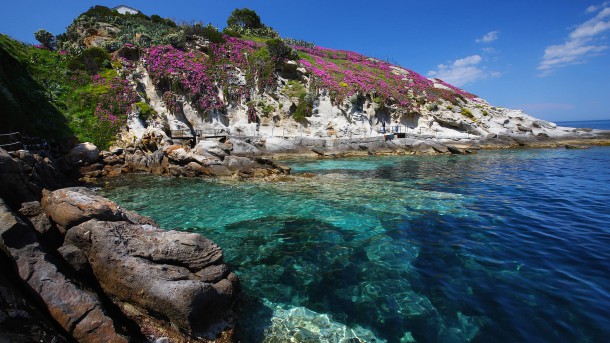This part of Elba is known locally as the “Small island within the island” as it is the most beautiful and naturally preserved and because of its special identity based on the union between the sea and the mountains, the beaches and the cliffs, the variety of flora and fauna and for the richness of the sea bed.
A narrow, winding road leads down to the sea, a few houses totally immersed in a luxuriant, natural landscape; at Capo Sant’Andrea the chestnut trees grow almost down to the fine, sandy beach, with its small jetty and water so clear that you can see the sea bed, even at its deepest points. At the side of the beach, a narrow path carved into the cliffs leads you to the discovery of unique rock formations; these are not ordinary cliffs, but dunes of orthoclase crystals encased in seven million year-old solidified granite magma An ideal place to sunbathe or walk in this moonlike landscape.
The Etruscans chose Capo Sant’Andrea long ago for its location and for the granite cliffs which protect the small bay so well from westerly winds. These famous ancestors of ours came to Cape St. Andrea for the fertility of the soil, the abundance of water and especially for the wood to burn for iron smelting. Still today, we can make out the mounds of dross deposit left over from making iron. Later on, the Romans crossed our seas busy with the heavy commercial traffic of those times; the amphorae found on two Roman shipwrecks discovered at Capo Sant’Andrea can now be seen in the Archaeology Museum in Marciana.
But Capo Sant’Andrea isn’t just about sea and sand! The great western headland of Elba, where Capo Sant’Andrea is situated, is the most mountainous part of the island and those who love walking can explore the beautiful hinterland of the mountains, where ancient trails and mule tracks can today be followed, thanks to new signposting. These paths lead to old settlements in a landscape framed by panoramic views and an extraordinarily vital, natural environment, rich in flora and fauna. Following the footpaths around Capo Sant’Andrea means discovering cyclamens, violets, flowering heather, anemones, broom, red lilies, delighting in the perfumes of the helichrysum, lavender, rosemary and mints, witnessing the sudden flight of a red partridge, surprising a group of mouflon as they graze or spotting an old abandoned shepherd’s hut or the remains of a pre-historic settlement.












